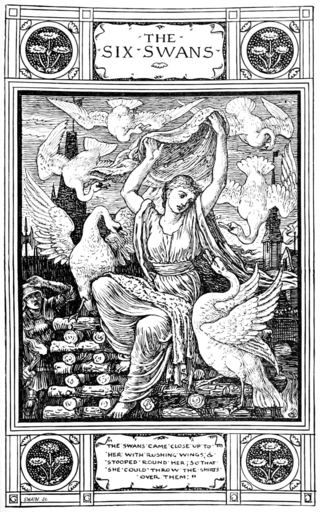
"Sleeping Beauty", also titled in English as The Sleeping Beauty in the Woods, is a fairy tale about a princess cursed by an evil fairy to sleep for a hundred years before being awakened by a handsome prince. A good fairy, knowing the princess would be frightened if alone when she wakes, uses her wand to put every living person and animal in the palace and forest asleep, to awaken when the princess does.

Giambattista Basile was an Italian poet, courtier, and fairy tale collector. His collections include the oldest recorded forms of many well-known European fairy tales. He is chiefly remembered for writing the collection of Neapolitan fairy tales known as Il Pentamerone.

Italian Folktales is a collection of 200 Italian folktales published in 1956 by Italo Calvino. Calvino began the project in 1954, influenced by Vladimir Propp's Morphology of the Folktale; his intention was to emulate the Straparola in producing a popular collection of Italian fairy tales for the general reader. He did not compile tales from listeners, but made extensive use of the existing work of folklorists; he noted the source of each individual tale, but warned that was merely the version he used.

The Pentamerone, subtitled Lo cunto de li cunti, is a seventeenth-century Neapolitan fairy tale collection by Italian poet and courtier Giambattista Basile.

"The Six Swans" is a German fairy tale collected by the Brothers Grimm in Grimm's Fairy Tales in 1812. It is of Aarne–Thompson type 451, commonly found throughout Europe. Other tales of this type include The Seven Ravens, The Twelve Wild Ducks, Udea and her Seven Brothers, The Wild Swans, and The Twelve Brothers. Andrew Lang included a variant of the tale in The Yellow Fairy Book.
The Canary Prince is an Italian fairy tale, the 18th tale in Italian Folktales by Italo Calvino. He took the tale from Turin, making various stylistic changes; he noted it developed a medieval motif, but such tales as Marie de France's Yonec produced a rather different effect, being tales of adultery. A variant on Rapunzel, Aarne–Thompson type 310, The Maiden in the Tower, it includes many motifs that differentiate it from that tale. Other fairy tales of this type include Anthousa, Xanthousa, Chrisomalousa, Petrosinella, Prunella, and Rapunzel.

"The Three Spinners" is a German fairy tale collected by the Brothers Grimm in Grimm's Fairy Tales. It is Aarne–Thompson type 501, which is widespread throughout Europe.
"The Pig King" or "King Pig" is an Italian literary fairy tale written by Giovanni Francesco Straparola in his The Facetious Nights of Straparola. Madame d'Aulnoy wrote a French, also literary, variant, titled Prince Marcassin.
The King who would have a Beautiful Wife or The King Who Wanted a Beautiful Wife is an Italian fairy tale collected by Laura Gonzenbach in Sicilianische Märchen. Thomas Crane included in his Italian Popular Tales, and Andrew Lang, in The Pink Fairy Book.
Prunella is an Italian fairy tale, originally known as Prezzemolina. Andrew Lang included it in The Grey Fairy Book. It is Aarne-Thompson type 310, the Maiden in the Tower.
"The Little Girl Sold with the Pears" is an Italian fairy tale published by Italo Calvino in Italian Folktales, from Piedmont. Ruth Manning-Sanders included a variant, as "The Girl in the Basket", in A Book of Ogres and Trolls. The tale was also republished by writer Jane Yolen as Brave Marietta.
The Flea is an Italian literary fairy tale written by Giambattista Basile in his 1634 work, the Pentamerone. It combines Aarne-Thompson-Uther types 857, "The Louse-Skin" and ATU 653, "The Four Skillful Brothers".
"The Three Sisters" or Green Meadow is an Italian literary fairy tale written by Giambattista Basile in his 1634 work, the Pentamerone. It tells the story of a maiden having secret encounters with a prince with the use of magic, him almost losing his life and her having to search for a cure for him.
Biancabella and the Snake is an Italian literary fairy tale written by Giovanni Francesco Straparola in The Facetious Nights of Straparola.
Sapia Liccarda is an Italian literary fairy tale written by Giambattista Basile in his 1634 work, the Pentamerone. It is not known whether he had a specific source, either literary or oral, for this tale.
The Three Enchanted Princes or The Three Animal Kings is an Italian literary fairy tale written by Giambattista Basile in his 1634 work, the Pentamerone. It is Aarne–Thompson–Uther Index ATU 552, "The Girls who married animals". At the end of the tale, the prince's brothers-in-law help him in defeating the dragon.
The Dragon is an Italian literary fairy tale, included in Giambattista Basile's Pentamerone, first published 1635. In the English language, the tale was a selection in Thomas Keightley's Fairy Mythology (1828), and later appeared in John Edward Taylor 's translation of the entire work, The Pentamerone, or, The Story of Stories, Fun for the Little Ones (1848). The tale has been classed as a version of Aarne–Thompson type 462 "the outcast queens and the ogress queen", rather than as "the dragon-slayer". It exhibits folklore motif K873, "fatal deception by giving narcotic."
The Golden Root or The Golden Trunk is a literary fairy tale written by Giambattista Basile in the Pentamerone, as the fourth story of the fifth day. It is considered to be one of two rewritings of the Graeco-Roman myth of "Cupid and Psyche" by Basile, the other being "Lo Catenaccio".
The Padlock is a literary fairy tale written by Giambattista Basile in the Pentamerone, as the ninth story of the second day.
King Crin is an Italian fairy tale collected by Antonio Arietti. Italian author Italo Calvino reworked the tale as King Crin in his work Italian Folktales.






